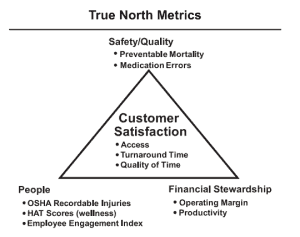One of the most powerful thoughts in the book On the Mend: Revolutionizing Healthcare to Save Lives and Transform the Industry (by John Toussaint MD and Roger Gerard PhD) is the quote; “the ultimate arrogance is to change the way people work without changing the way we manage them.”
While ThedaCare started their journey with a series of weeklong “Rapid Improvement Events,” they learned that leaders at all levels had to adapt and change their ways, from top to bottom, for a Lean culture to take root for the sake of their patients, staff members, and organization. Conflict of interest statement: I used to work for the Lean Enterprise Institute, which published On the Mend and had a partnership with the ThedaCare Center for Healthcare Value).
Toussaint has posted, via his blog, an article that appeared in The Joint Commission Journal on Quality and Patient Safety called “ThedaCare's Business Performance System: Sustainable Continuous Daily Improvement Through Hospital Management in a Lean Environment” by one of their senior leaders, Kim Barnas.
I'm a big admirer of ThedaCare's work, having visited a number of times over the past three years (admittedly not working there, nor did I ever serve as a consultant for them). When you visit, there's a palpable sense that the culture is different and that you're hearing and seeing a very consistent model of Lean leadership from current CEO Dean Gruner MD, middle managers, and front line managers.
The article describes their daily management system, including “standardized work for leaders.” As with any standardized work, the existence of it does not cause managers to turn into robots who are just checking boxes. The standardized work guides them in terms of how they use their time, such as the two-hour “no-meeting zone” at the start of each day, a standard that frees up more time for coaching at the gemba, or the place where the work is actually done (as opposed to spending more time in one's office catching up on email).
There's a lot of great stuff in the article. I won't attempt to comment on all of it — please check out the article.
I'll write about one aspect that caught my eye. It's great that ThedaCare leaders recognized the need to shift course in their Lean journey. They were savings tens of millions of dollars through their Events, but they realized they needed to change the culture for longer term success.
What exactly prompted them to change?
From the article:
During the first five years of this journey, ThedaCare achieved significant improvements in quality and the elimination of waste—the hallmarks of Lean thinking – through the development of the ThedaCare Improvement System (TIS), which included Value Stream analysis, rapid improvement events, and projects applied to specific processes. However, we did not meet our goals for continuous daily improvement, particularly our goal of increasing productivity by 10% annually.
Improving healthcare productivity is an admirable and important goal, especially when Lean improvements bring measurable improvements in quality and safety, waiting time, and cost all together (as ThedaCare has demonstrated with the data in numerous articles, including this one).
Another healthcare CEO (one whose hospital has also been on a Lean journey nearly as long as ThedaCare, about 9 years), caught my attention by saying at a conference a few years back that healthcare is probably the only industry with NEGATIVE productivity growth over the years. This is a big problem in healthcare. Technology and computer systems might help, but they aren't a silver bullet. We need the process improvements, staff-driven work redesign, and leadership changes that we see at ThedaCare and other leading Lean hospitals. The British NHS has a great need to improve productivity, as well. From the BBC article:
“Why, when so much is known about what drives and can improve efficiency, has hospital productivity deteriorated?
Back to ThedaCare… my background and education in Dr. Deming's principles made me pause and think about that 10% target. Dr. Deming warned, in his 14 points:
10) Eliminate slogans, exhortations, and targets for the workforce asking for zero defects and new levels of productivity. Such exhortations only create adversarial relationships, as the bulk of the causes of low quality and low productivity belong to the system and thus lie beyond the power of the work force.
11a) Eliminate work standards (quotas) on the factory floor. Substitute leadership.
11b) Eliminate management by objective. Eliminate management by numbers, numerical goals. Substitute leadership.
I'm not sure that the ThedaCare 10% improvement goal really caused an “adversarial relationship.” I will give ThedaCare leaders for recognizing that their leadership was required and that they needed to work to improve the system, including the management system.
I'll give ThedaCare leaders credit for not blaming the staff members and managers for not hitting that 10% goal. Where did 10% come from? It's a nice round number. It sounds good. Apparently, the system wasn't capable of creating 10% productivity improvement and ThedaCare leaders recognized that and improved the system (as described in the article). The article states that, from 2008 and 2009, they had departments that had anywhere from 1% to 11% improvement, so they are still not quite hitting that goal. But is the goal really the right measure?
 What do you think about goals like this? Is it enough to say, as leaders, “we need to work together to improve our systems and processes so that we can achieve balanced improvement in quality, safety, access, and cost (productivity)” or do you need specific goals? Western management (as Dr. Deming wrote about decades ago) still loves the idea that goals and targets motivate people. You have goals, “stretch goals,” and “super stretch goals.” But, do you really need the numerical target? Do balanced directional goals, without numbers (as shown in the ThedaCare “True North” illustration in the article – click for a larger view) enough? If people are naturally motivated to improve and provide better patient care, do they need a goal?
What do you think about goals like this? Is it enough to say, as leaders, “we need to work together to improve our systems and processes so that we can achieve balanced improvement in quality, safety, access, and cost (productivity)” or do you need specific goals? Western management (as Dr. Deming wrote about decades ago) still loves the idea that goals and targets motivate people. You have goals, “stretch goals,” and “super stretch goals.” But, do you really need the numerical target? Do balanced directional goals, without numbers (as shown in the ThedaCare “True North” illustration in the article – click for a larger view) enough? If people are naturally motivated to improve and provide better patient care, do they need a goal?
In many settings, people will “game the numbers” to hit a target, often out of fear for their own jobs (as did Andy Bernard on “The Office”). Again, I'd be surprised if this was happening at ThedaCare, but given human nature, you have to be careful with targets, quotas, and incentives, even a well intended one in a good culture. Again, I have immense respect for the entire team at ThedaCare, but I thought this “10% thing” would be an interesting and constructive discussion point.
Here's a related video of John Toussaint talking about standardized work for leaders.
Please scroll down (or click) to post a comment. Connect with me on LinkedIn.
Let’s work together to build a culture of continuous improvement and psychological safety. If you're a leader looking to create lasting change—not just projects—I help organizations:
- Engage people at all levels in sustainable improvement
- Shift from fear of mistakes to learning from them
- Apply Lean thinking in practical, people-centered ways
Interested in coaching or a keynote talk? Let’s start a conversation.










Mark,
I appreciate your comments and your pushback on the 10% number. I think what we learned is that without a different management system, a lean management system,you can set all the targets you want and it won’t matter. True respect for people dictates they have the training, tools,and I would add, management system to do work that gives their life meaning. 10%,5%,1%, isn’t the point it’s the standard work for leaders that most organizations are lacking.
One final point, I believe setting the bar high is better than not if you have developed the culture of respect and management by process not objectives as Deming so appropriately pointed out.Thanks for your post.
John
Hi John – thanks for your reply. I agree with what you’re saying that setting targets alone won’t do much. As I wrote, I appreciate that ThedaCare leadership wasn’t just setting targets without a method to get there.
I’m sure we’re in agreement that the worst thing an organization could do is tell leaders “hit a 10% target or else” because then we’d see all sorts of stupid cost cutting and staffing might get cut back to a level where patient safety is threatened.
So, I appreciate the ThedaCare stance that safety and quality come first. In a way, it’s encouraging that not every department hit the 10% target, as it’s a sign they weren’t compromising anything just to hit a goal.
Mark
[…] note: Today’s guest post by Bart Sellers is a timely contribution to follow up to yesterday’s post about the ThedaCare Business Performance System and the journal article about that great work. Bart […]